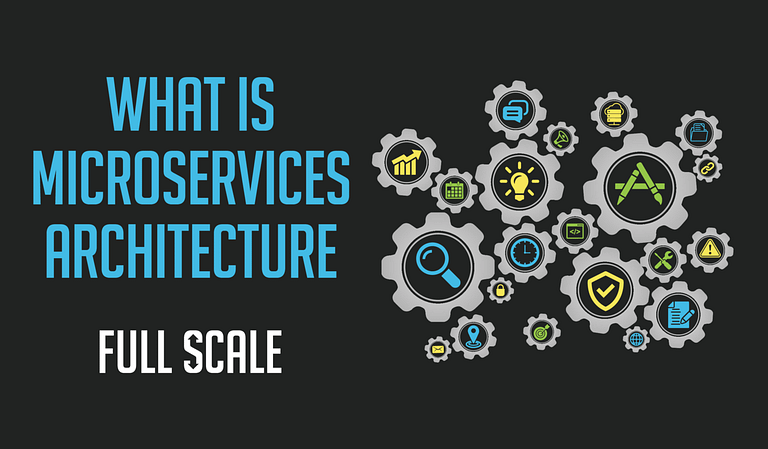Modern problems call for modern solutions. Recent times have shown the relevance of microservices architecture in software development. How? Let’s find out.
The realm of software development moves fast. As systems become more complex, the demand for innovative solutions also continues to arise. With scalability and future-proofing as major concerns for many businesses, it’s high time to incorporate relevant technologies that solve these problems.
Enter Microservices. The adoption of microservices architecture in software development has experienced a surge in recent years. By far, it’s been transforming the way applications are designed by teams and deployed to the market. But before we explore how microservices accelerated in software development, let’s quickly dip into its core definition.
What Is A Microservices Architecture?
At its core, microservices architecture is a design approach to building software applications comprising loosely coupled, independently deployable services.
In contrast to traditional monolithic applications, where all components are tightly integrated into a single codebase, microservices operate in modules. Each service represents a specific business capability and operates as an autonomous unit with its own database. This architecture allows organizations to develop, deploy, and scale services independently.
These services communicate through well-defined application programming interfaces (APIs). The allowance for flexibility allows organizations to choose the most suitable technology stack for each service. Moreover, decentralizing each functionality improves agility, scalability, and resilience since teams can update and scale specific services without impacting the entire application.
You might be skeptical about microservices being independent of each other and can possibly ruin the entire system. Even though the services are responsible for their discrete tasks, they still communicate with each other through APIs. Let’s explore how microservices work more.
How Is Microservices Architecture Used?
Microservices architecture is not a new thing in the tech industry. As a matter of fact, big-name companies use microservice architecture in their applications—companies such as Uber, Netflix, Amazon, Comcast Cable, etc.
These organizations use microservices differently but share one goal to break up monolithic apps into smaller components. Here are some microservices architecture examples:
- Media Content – You can store video assets and images in scalable object storage systems. These are served directly to the users through desktop or mobile devices.
- Data Processing – Extend cloud support to your existing modular data processing service.
- Website migration – You can safely migrate to a container-based microservices platform if your website is currently in a monolithic platform.
- Transaction and invoices – Since microservices architecture allows independent services, you can separate payment and processing as an independent unit. This way, you can still accept payment even if invoicing ceases to work.
How Do Businesses Benefit from Microservices Architecture?
Small Components
Businesses benefit greatly from Microservices Architecture, especially now that many new technologies support this design. Here are some of the microservice benefits that will convince you:
By definition, microservices mean that a complex application is broken down into multiple manageable components or services. With that, your team of developers can quickly deploy, tweak, and redeploy each component independently without compromising the whole system.
Improved Fault Isolation
When an error occurs in one of the services, the application will not stop functioning. Furthermore, you can easily detect which service has a problem and focus your efforts on the area. Once fixed, you can redeploy that particular component alone, not the entire application.
Built for Business
Since this application consists of small components, you can have small teams of developers work on different service boundaries. This approach is a less time-consuming process and makes it easier to scale up the development effort if the need arises.
Decentralized
A decentralized system is one of the highlights of microservices architecture; it is an inclusive way of designing an application. Microservices do not require a single technology, platform, or programming language. In short, centralized governance is not optimal.
Getting Started with Microservices Architecture
Now that we know the identity of microservices, their uses, and how businesses can benefit from them. If you think that microservices may be best for your business, you may need to migrate your existing platform or start a new project. But how do you get started with microservices?
Worry not because there are common themes that organizations have adopted. Although no standard or defined principles exist for building better with microservices architecture, these may still sound promising.
Decompose
One of the things that you need to do before you start building is to identify and define your business capabilities. Here are examples of the business capabilities of an online shop application:
- Inventory management
- Order management
- Product catalog
- Product reviews management
- User management
Once you identify these capabilities, you can start building services corresponding to each. You can have a team of one or two expert developers build each service.
Design the Services Intricately
In building the service, make sure that you clearly define what to expose. Also, decide what protocols to use to interact with the service. Hide all complexities from the client side and disclose only relevant details.
Decentralize
To decentralize would mean that teams who build the service will take responsibility and care for everything related to that service. That would include the development, deployment, maintenance, and support.
With that, there is no need for a separate support or maintenance team. When a developer needs to make changes to the services, there is no need to submit a request. They can check the code and work on it themselves.
Microservices Architecture’s Rise in Software Development
We’ve developed a foundational understanding of microservices architecture. This architectural paradigm, characterized by breaking down monolithic structures into smaller, independent services, has become a cornerstone for organizations aiming to boost agility, scalability, and innovation. Now, let’s explore the phases that have catapulted its adoption and relevance in the realm of software development today.
Phase 1: Breaking Free from Monoliths
Traditionally, software applications were developed as monoliths. This means that all software system components are tightly integrated into a single codebase. For a long time, this approach is functional. However, it posed challenges in terms of scalability and maintenance over time.
The shift towards Microservices began with companies recognizing the advantages of modularization. When you use monolithic architecture, you risk impacting other components when you only intend to update, fix, or deploy one functionality. Companies with complex systems adopted microservices architecture in software development to aid issues associated with monolithic applications.
For instance, Netflix transitioned from a monolithic architecture to a microservices-based one. This transition has allowed more efficient updates and maintenance of their video streaming platform.
Phase 2: Embracing DevOps and CI/CD
DevOps, short for Development and Operations, is a set of practices, principles, and cultural philosophies to improve collaboration and communication between software development and IT operations teams. The primary goal of DevOps is to shorten the software development life cycle and continuously deliver high-quality software.
The rise of DevOps practices has impacted the acceleration of microservices architecture in software development. DevOps encourages collaboration, automation, security, feedback, and continuous delivery. These characteristics align seamlessly with the principles of microservices.
For example, Amazon Web Services (AWS) leverages microservices and DevOps to enable rapid and continuous deployment of services. In this way, teams can ensure the seamless rollout of updates and minimize downtime to enhance the overall system reliability.
Phase 3: Scalability and Elasticity for Modern Applications
In response to the escalating demands of digital applications, scalability has become a necessity, particularly with the advancement of cloud computing.
Microservices architecture inherently offers scalability by allowing organizations to scale specific services independently. For instance, Uber utilizes microservices and containerization through Docker to scale its services horizontally. This model ensures that each component can be efficiently scaled based on demand, optimizing resource utilization and cost-effectiveness.
Phase 4: Polyglot Persistence and Decentralized Data Management
Microservices architecture encourages the use of polyglot persistence. Polyglot persistence is a concept that utilizes specific data storage approaches and technologies to support unique storage requirements depending on data types within enterprise applications. In short, this model enables each service to choose the most suitable database for its specific needs.
An example of this is Airbnb. The online marketplace platform employs microservices with a polyglot approach to data storage. Different services within the Airbnb ecosystem utilize databases that align with their data models. With this architecture, the platform optimizes greater flexibility and adaptability to diverse data requirements.
Phase 5: Enhanced Fault Isolation and Resilience
With a modular design, microservices can enhance fault isolation, a crucial aspect of building resilient systems. This approach enhances the overall resilience of a software application, ensuring uninterrupted service even in the face of component failures.
A notable example is the global payment platform, PayPal. PayPal ensures that a failure in one microservice does not cascade across the entire system. How do they do it? The platform adopts the microservices architecture and implements fault-tolerant design patterns like circuit breakers.
Microservices Architecture Moving Forward
The acceleration of microservices architecture in software development has unraveled in various facets. Each facet heightens the need to use microservices triggered by technological advancements, strategic organizational shifts, or complex requirements.
From liberating applications from monolithic constraints to embracing DevOps, scalability, decentralized data management, and resilience, these phases collectively contribute to the increasing relevance and demand for microservices. As organizations prioritize agility, scalability, and rapid innovation, microservices architecture remains an innovative solution that helps shape the future software development landscape.
Build Your Technology with Microservices Architecture Today
Are you ready to take your business into the future? You’re going to need the help of experts in the field of software development.
At Full Scale, we house some of the most talented software development professionals you can hire. We specialize in assembling and augmenting the right combination of software experts for you. Each team member has been screened, interviewed, and assessed so they come out ready to join your team.
So whether your team needs software developers, QA testers, project managers, content specialists, or graphic designers, Full Scale can help.



